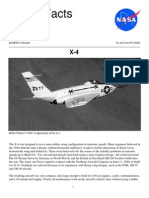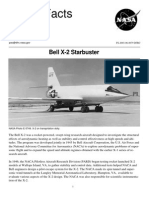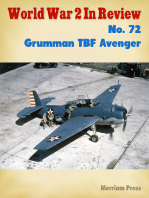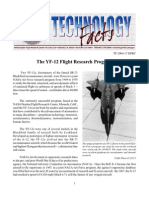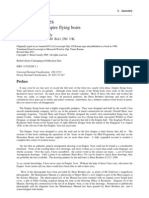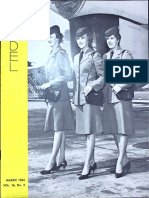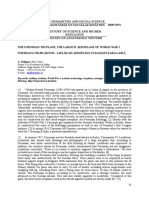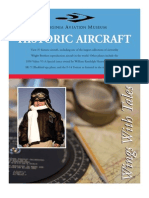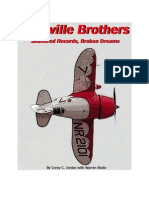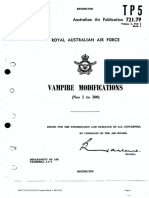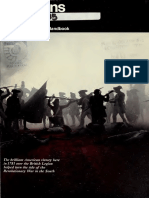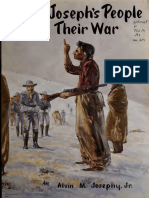Nasa Facts XF-92A
Nasa Facts XF-92A
Uploaded by
Bob AndrepontCopyright:
Available Formats
Nasa Facts XF-92A
Nasa Facts XF-92A
Uploaded by
Bob AndrepontCopyright
Available Formats
Share this document
Did you find this document useful?
Is this content inappropriate?
Copyright:
Available Formats
Nasa Facts XF-92A
Nasa Facts XF-92A
Uploaded by
Bob AndrepontCopyright:
Available Formats
NASA Facts
National Aeronautics and Space Administration Dryden Flight Research Center P.O. Box 273 Edwards, California 93523 Voice 661-276-3449 FAX 661-276-3566 pao@dfrc.nasa.gov FS-2003-06-080 DFRC
XF-92A
NASA Photo E-17346. XF-92A in Flight.
By the late 1930s, it was clear that traditional straight wings and relatively thick airfoils were not suitable for flight approaching the speed of sound. As a result, new swept-back wing shapes were proposed to reduced high drag and other problems which appeared at transonic speeds. One of these new shapes was developed by a German scientist, Alexander M. Lippisch. He proposed a triangular delta wing, so named because it resembled the Greek letter delta. This shape had a number of advantages. A delta wing combined a sharp angle which reduced drag, with a large surface area that increased lift. The wing could be built very thin, but was still very strong. During World War II, Lippisch built a delta wing glider to test the shapes low-speed characteristics. As the Allied armies advanced into Germany in the spring of 1945, reports about delta wing research were captured. Both Lippisch and his glider fell into Allied hands at the end of the war. The NACA wind tunnel research independently confirmed the potential of a delta wing at high speeds. Engineers at ConsolidatedVultee, who were designing the XF-92 interceptor, were interested in the delta wing. Conferences with Lippisch convinced them that a delta wing would work.
1
The Consolidated-Vultee Model 7002 aircraft was built as a flying mock-up to investigate delta wing behavior at low and high subsonic speeds for the proposed XF-92 delta wing interceptor. Powered by a ramjet with small rockets inside the combustion chamber, it would have been a manned surface to air missile, with a short range, Mach 1.65 top speed, and a flight time at high altitude of 5.4 minutes. The XF92s engine was soon determined to be impractical, and the project was canceled in 1948. Although the XF-92 program had ended, the Model 7002 was being prepared to fly. Its role remained that of a test vehicle for the delta wing configuration. The aircraft was delivered to Muroc Air Force Bace on April 1, 1948. Its first flight, an inadvertent hop during a high-speed taxi test was made on June 9, 1948, by Consolidated-Vultee test pilot Sam Shannon. Theofficial first flight was made on Sept. 18, and the Phase I testing began. This demonstrated that the
NASA Photo E-860. XF-92A on ramp.
was turned over to the Air Force for Phase II testing by Maj. Charles E. Chuck Yeager. The aircraft was given the Air Force designation XF-92A, and carried the serial number 46-692. Although the aircraft carried the designation of a prototype fighter, its role was now that of research aircraft. The Phase II flights were tests by Air Force pilots to see if the aircraft met the contract specifications. The first Phase II flight was made by Yeager on Oct. 13, 1949. (A day short of two years after his Mach 1 flight.) The tests were completed with a final flight on Dec. 28, 1949, by Maj. Frank Everest. The XF-92A Phase I and II tests were over, but it was flown occasionally over the next three years. Primarily, these were tests of the aircrafts performance and its J33 engine by Yeager and Everest. The aircraft was also used for familiarization flights by other Air Force pilots. These included Col. Albert Boyd, Col. Fred Ascani, Maj. Jack Ridley, Capt. Joe Wolfe, Capt. Arthur Kit Murray, and Lt. James Smash Nash. The XF-92As most unusual use was in the movie Jet Pilot, for which it was painted as a Soviet MiG-23 fighter. Between May of 1950 and July of 1951 the XF-92A was at the Consolidated-Vultee plant in San Diego. Following its return to Edwards, a fire damaged the tail cone of the aircraft during a ground run on Dec. 3, 1951. The XF-92A was grounded for repairs until February 1952. Further problems prevented any additional flights until June 1952. The Air Force completed its tests with the XF-92A in Feb. 1953, and turned the aircraft over to the NACA. A. Scott Crossfield was the NACA pilot selected for the XF-92A research flights. His introduction to the
NASA Photo E-953. XF-92A on ramp.
aircraft was airworthy, and continued through Aug. of 1949. The Phase I flights were conducted by both Shannon and fellow company test pilot William Martin. With the final flight on August 26, 1949, the aircraft
2
aircraft, during a taxi across the lakebed, was memorable. He recalled years later, Nobody wanted to fly the XF-92. There was no lineup of pilots for that airplane. It was a miserable flying beast. Before the taxi, Everest briefed Crossfield, who recalled, He told me, Keep the nose up so it will slow down. Because it will roll a long ways. Well, I let the nose come down and on the nose wheel. I couldnt get it back up. It didnt have enough tail power to do it. So that airplane was rolling like mad towards the edge of the lakebed.... I saw a county road off to the left. And I managed to get that thing turned and head up that country road. Burned out the brakes. Just melted them right there. Rolled up that county road about 100 yards. And fortunately no damage to the airplane. Came out pretty well, except the brakes were all burned out. The road was later named Crossfield Pike. Crossfield flew a total of 25 flights in the XF-92A between April 9, 1953 and Oct. 14, 1953. The initial 13 flights were for data on static longitudinal stability; dynamic stability; directional control; longitudinal and lateral stability and control, and low speed stability
NASA Photo E-2889. NACA Research Aircraft - Bell X-1A, D-558-1, SF-92A, X-5, D-558-II, X-4, and X-3.
and control. These were followed by 10 flights to test different wing fence configurations. The wing fences were designed to control the tendency of swept wing aircraft to pitch up at low speeds and in turns. The initial six flights were made at speeds under Mach 1. The last four were for data on low-speed lateral and directional control with the wing fences. On one flight, the modified wing fences buckled during the test. The XF-92A undertook two low-speed lateral and directional control flights without the wing fences. These were both made on Oct. 14, 1953. When the XF-92A landed on the lakebed after the second flight, its nose gear collapsed. Crossfield was unharmed, but the XF92A never flew again. The Air Force subsequently donated the XF-92A to the University of the South in Sewanee, Tenn. The aircraft was transferred to the Air Force Museum in 1969, where it is now on display. The XF-92A showed that a delta-wing aircraft was practical, but, as Crossfield noted, the aircraft itself had shortcomings. It had severe pitch up problems, which often exceeded 6 gs, and once exceeded 8gs. Convair (the new name for Consolidated-Vultee) corrected the problems, and used the XF-92A experience in the later development of the F-102 and F-106 interceptor, the XF2Y-1 Sea Dart jet seaplane fighter, and the B-58 strategic bomber. In France, the Mirage aircraft also used delta wings, while the European Typhoon carries the delta wing into the 21st century.
NASA Photo E-1005. Flap Calibration
You might also like
- Archive 1988Document112 pagesArchive 1988c737100% (2)
- Sopwith Camel - Stability AnalysisDocument54 pagesSopwith Camel - Stability AnalysisRobbie Henderson100% (1)
- Atlas Engineering Early Australian Ship BuildingDocument8 pagesAtlas Engineering Early Australian Ship BuildingparkbenchbruceNo ratings yet
- X-47B UcasDocument2 pagesX-47B Ucashuesos1488No ratings yet
- A Charming Field For An EncounterDocument76 pagesA Charming Field For An EncounterBob Andrepont100% (2)
- NASA 121581main FS-078-DFRCDocument3 pagesNASA 121581main FS-078-DFRCNASAdocumentsNo ratings yet
- NASA Facts Bell X-2 Star BusterDocument4 pagesNASA Facts Bell X-2 Star BusterBob AndrepontNo ratings yet
- NASA 121583main FS-081-DFRCDocument3 pagesNASA 121583main FS-081-DFRCNASAdocumentsNo ratings yet
- The Beginning of Naval Aviation: Updated 11/09/2012Document27 pagesThe Beginning of Naval Aviation: Updated 11/09/2012Haerul Imam0% (1)
- NASA Facts The Lockheed YF-12 1999Document5 pagesNASA Facts The Lockheed YF-12 1999Bob Andrepont100% (1)
- NASA 120324main FS-082-DFRCDocument3 pagesNASA 120324main FS-082-DFRCNASAdocumentsNo ratings yet
- Not Without Adversity: Sir Lawrence Wackett, Aircr Aft PioneerDocument4 pagesNot Without Adversity: Sir Lawrence Wackett, Aircr Aft Pioneer117kitchenerNo ratings yet
- Trying To Tame A Bearcat StoryDocument6 pagesTrying To Tame A Bearcat StorytrojandlNo ratings yet
- OV 10 StoryDocument16 pagesOV 10 StoryUSMC_AnglicoNo ratings yet
- 1934 PARIS AIRSHOW REPORT - Part1 PDFDocument11 pages1934 PARIS AIRSHOW REPORT - Part1 PDFstarsalingsoul8000No ratings yet
- A2A Cherokee180 Pilot's ManualDocument104 pagesA2A Cherokee180 Pilot's ManualCapi MarketingNo ratings yet
- Heinkel He 64 C Sport Airplane (German)Document9 pagesHeinkel He 64 C Sport Airplane (German)SnautzerNo ratings yet
- Junkers Ju88A 6Document4 pagesJunkers Ju88A 6lucianoNo ratings yet
- Errata Sheet For "The B-52 Competition of 1946... and Dark Horses From Douglas, 1947-1950 (The American Aerospace Archive 3) "Document5 pagesErrata Sheet For "The B-52 Competition of 1946... and Dark Horses From Douglas, 1947-1950 (The American Aerospace Archive 3) "Jared ZichekNo ratings yet
- BAC Canberra: Bomber, ReconDocument4 pagesBAC Canberra: Bomber, ReconAlice Bot100% (1)
- Flight Journal 03.04 2024Document68 pagesFlight Journal 03.04 2024LUIGI0% (1)
- Us Military Aircraft DesignationsDocument4 pagesUs Military Aircraft Designationserik_xNo ratings yet
- Flight Research at Ames Fifty-Seven Years of Development and Validation of Aeronautical TechnologyDocument122 pagesFlight Research at Ames Fifty-Seven Years of Development and Validation of Aeronautical TechnologyBob Andrepont100% (1)
- Aircraft Described. Curtis SBC-4 Part Two. Model Builder January 1981Document2 pagesAircraft Described. Curtis SBC-4 Part Two. Model Builder January 1981AmaruTincopaNo ratings yet
- Aviacion - Aviones XDocument65 pagesAviacion - Aviones XsincobrarenfechaNo ratings yet
- Mason X-29 Story v3Document13 pagesMason X-29 Story v3joe aeromaverick100% (1)
- Handley Page VictorDocument18 pagesHandley Page VictorMoshe Rubin0% (2)
- Part2-By Type Designator (Decode) PDFDocument85 pagesPart2-By Type Designator (Decode) PDFkgn1No ratings yet
- Hiller Aviation Museum Mar 2010Document10 pagesHiller Aviation Museum Mar 2010CAP History LibraryNo ratings yet
- NASA: 89236main TF-2004-17-DFRCDocument7 pagesNASA: 89236main TF-2004-17-DFRCNASAdocumentsNo ratings yet
- North American T-6 TexanDocument5 pagesNorth American T-6 TexanAviation/Space History Library100% (2)
- IAF Aircraft InventoryDocument31 pagesIAF Aircraft InventoryAll Agui Son100% (2)
- NASA 120395main FS-010-DFRCDocument2 pagesNASA 120395main FS-010-DFRCNASAdocumentsNo ratings yet
- Flying Empires Book DocumentsDocument201 pagesFlying Empires Book Documentsjohncrusoe100% (1)
- Air Force Legends SeriesDocument2 pagesAir Force Legends SeriesFabricius Gamayev100% (1)
- Roundel 1964-03 Vol 16 No 2Document36 pagesRoundel 1964-03 Vol 16 No 2Tate0% (1)
- Portsmouth AerocarDocument24 pagesPortsmouth Aerocar117kitchenerNo ratings yet
- Elegance in Flight PDFDocument488 pagesElegance in Flight PDFAndreu Guimerà BuletNo ratings yet
- Giant Tri PlaneDocument10 pagesGiant Tri PlaneLes ChattonogaNo ratings yet
- Virginia Aviation Museum Jan 2012Document33 pagesVirginia Aviation Museum Jan 2012CAP History Library0% (1)
- Granville Brothers: Shattered Records, Broken DreamsDocument14 pagesGranville Brothers: Shattered Records, Broken DreamsCorey C. Jordan100% (3)
- Harry CobbyDocument11 pagesHarry Cobbya1sdfghjklNo ratings yet
- 64th Aggressor Squadron Naval Standard Operating Procedures V100Document30 pages64th Aggressor Squadron Naval Standard Operating Procedures V100Muhammad MoizNo ratings yet
- Old Registration of Pia AircraftDocument5 pagesOld Registration of Pia AircraftRashid MurtazaNo ratings yet
- Gloster Meteor MK 7Document0 pagesGloster Meteor MK 7albix58No ratings yet
- Air Defense of Darwin 42-44Document3 pagesAir Defense of Darwin 42-44Alvaro Dennis Castro GuevaraNo ratings yet
- Vampire FB.30 Modifications List Pt.1Document526 pagesVampire FB.30 Modifications List Pt.1Left VentricleNo ratings yet
- Howard Pixton: Test Pilot & Pioneer Aviator: The Biography of the First British Schneider Trophy WinnerFrom EverandHoward Pixton: Test Pilot & Pioneer Aviator: The Biography of the First British Schneider Trophy WinnerNo ratings yet
- Maryland, Virginia, and Washington D.C. Warbird Survivors 2003: A Handbook on Where to Find ThemFrom EverandMaryland, Virginia, and Washington D.C. Warbird Survivors 2003: A Handbook on Where to Find ThemNo ratings yet
- The Patricia Lynn Project: Vietnam War, the Early Years of Air IntelligenceFrom EverandThe Patricia Lynn Project: Vietnam War, the Early Years of Air IntelligenceNo ratings yet
- Nevada Warbird Survivors 2002: A Handbook on Where to Find ThemFrom EverandNevada Warbird Survivors 2002: A Handbook on Where to Find ThemNo ratings yet
- Wings That Stay on: The Role of Fighter Aircraft in WarFrom EverandWings That Stay on: The Role of Fighter Aircraft in WarRating: 3 out of 5 stars3/5 (1)
- American: Here Over The British Turn The The TheDocument100 pagesAmerican: Here Over The British Turn The The TheBob Andrepont100% (1)
- Arkansas Post National MemorialDocument2 pagesArkansas Post National MemorialBob Andrepont100% (1)
- Chickamauga and Chattanooga BattlefiledsDocument68 pagesChickamauga and Chattanooga BattlefiledsBob Andrepont100% (4)
- Boston and The American RevolutionDocument100 pagesBoston and The American RevolutionBob Andrepont100% (2)
- Battlefields Around Fredericksburg PDFDocument48 pagesBattlefields Around Fredericksburg PDFBob Andrepont100% (2)
- Chief Joseph's People and Their WarDocument28 pagesChief Joseph's People and Their WarBob Andrepont100% (1)
- Campaign For PetersburgDocument84 pagesCampaign For PetersburgBob Andrepont100% (3)
- Castillo de San MarcosDocument70 pagesCastillo de San MarcosBob Andrepont100% (2)
- ChalmetteDocument64 pagesChalmetteBob Andrepont100% (1)
- A Thunder of CannonDocument249 pagesA Thunder of CannonBob Andrepont80% (5)
- AntietamDocument68 pagesAntietamBob Andrepont100% (3)
- The Occupation of MexicoDocument48 pagesThe Occupation of MexicoBob Andrepont100% (1)
- Their Stories Women in The U.S.-mexican WarDocument2 pagesTheir Stories Women in The U.S.-mexican WarBob AndrepontNo ratings yet
- From The Golden Gate To Mexico City The U.S. Army Topographical Engineers in The Mexican War, 1846-1848Document372 pagesFrom The Golden Gate To Mexico City The U.S. Army Topographical Engineers in The Mexican War, 1846-1848Bob AndrepontNo ratings yet
- Lock Stock and BarrelDocument2 pagesLock Stock and BarrelBob Andrepont100% (3)
- Desperate Stand The Battle of Buena VistaDocument44 pagesDesperate Stand The Battle of Buena VistaBob Andrepont100% (1)
- The Gulf Theater, 1813-1815Document52 pagesThe Gulf Theater, 1813-1815Bob Andrepont100% (1)
- Guns Along The Rio Grand Palo Alto and Resaca de La PalmaDocument32 pagesGuns Along The Rio Grand Palo Alto and Resaca de La PalmaBob AndrepontNo ratings yet
- Advanced Redoubt of Fort BarrancasDocument2 pagesAdvanced Redoubt of Fort BarrancasBob AndrepontNo ratings yet
- The Civil War On The Atlantic Coast, 1861-1865Document64 pagesThe Civil War On The Atlantic Coast, 1861-1865Bob Andrepont100% (4)
- The Civil War in The Trans-Mississippi Theater, 1861-1865Document60 pagesThe Civil War in The Trans-Mississippi Theater, 1861-1865Bob Andrepont100% (4)
- The Maryland and Fredericksburg Campaigns, 1862-1863Document64 pagesThe Maryland and Fredericksburg Campaigns, 1862-1863Bob Andrepont100% (2)
- CMH Pub 73-1 - Mexican War - Gateway South The Campaign For MonterreyDocument36 pagesCMH Pub 73-1 - Mexican War - Gateway South The Campaign For Monterreyorabera100% (1)
- A House DividedDocument1 pageA House DividedBob AndrepontNo ratings yet
- The Petersburg and Appomattox Campaigns, 1864-1865Document72 pagesThe Petersburg and Appomattox Campaigns, 1864-1865Bob Andrepont100% (4)
- CMH Pub 75-18 The Army and Reconstruction, 1865-1877Document76 pagesCMH Pub 75-18 The Army and Reconstruction, 1865-1877Bob Andrepont100% (3)
- Dust Off Army Aeromedical Evacuation in VietnamDocument148 pagesDust Off Army Aeromedical Evacuation in VietnamBob Andrepont100% (2)
- The Civil War Ends, 1865Document76 pagesThe Civil War Ends, 1865Bob Andrepont100% (2)
- Atlanta and Savannah Campaigns - 1864Document84 pagesAtlanta and Savannah Campaigns - 1864Bob Andrepont100% (4)






